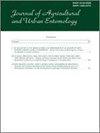Distribution of Biting Flies Associated with Swine Production Facilities in the Southeastern United States
Q2 Agricultural and Biological Sciences
引用次数: 0
Abstract
ABSTRACT High populations of pest flies on swine facilities can be detrimental to the animals and producers. The purpose of this study was to identify the distribution pattern and the influence of habitats on distribution of adult biting flies surrounding commercial swine production barns in North Carolina. In this study, fly surveillance was conducted on four swine facilities in Bladen County, North Carolina, U.S.A., from January to October 2019. Biting flies typically associated with livestock were passively collected weekly on sticky traps, which were placed in three concentric circles surrounding swine barns, and then counted and identified. Stable flies [Stomoxys calcitrans (L.); Diptera: Muscidae] were most abundant on swine facilities that were mixed-use with pastured beef cattle. However, swine producers with no pastured cattle should be aware of the potential for stable flies to disperse from off-property larval development sites. Therefore, adult fly management may be necessary if populations reach nuisance levels. Horse and deer fly (Diptera: Tabanidae) captures were not related to trap proximity to water. Differences in horse and deer fly trap captures was likely less of a reflection of differences in potential fly development habitat quality (e.g., water) and more related to adult fly habitat selection.与美国东南部养猪设施有关的咬蝇分布
摘要:养猪设施中害虫蝇的大量繁殖可能对动物和生产商造成危害。本研究的目的是确定北卡罗来纳州商业养猪场周围成年咬蝇的分布模式和栖息地对其分布的影响。在这项研究中,于2019年1月至10月对美国北卡罗来纳州布莱登县的四个猪设施进行了蝇类监测。通常与牲畜有关的叮咬苍蝇每周都会被被动地收集在粘性陷阱中,这些陷阱被放置在猪谷仓周围的三个同心圆中,然后进行计数和识别。稳定的苍蝇[Stomoxys calcitrans(L.);直翅目:蝇科]在与牧场肉牛混合使用的猪设施中最为丰富。然而,没有牧场牛的猪生产商应该意识到稳定的苍蝇可能会从场外幼虫发育点扩散。因此,如果种群数量达到令人讨厌的水平,成年苍蝇的管理可能是必要的。捕捉到的马和鹿蝇(Diptera:Tabanidae)与诱捕器靠近水域无关。捕捉马和鹿蝇笼的差异可能不太反映潜在苍蝇发育栖息地质量(如水)的差异,而更多地与成年苍蝇栖息地的选择有关。
本文章由计算机程序翻译,如有差异,请以英文原文为准。
求助全文
约1分钟内获得全文
求助全文
来源期刊

The Journal of Agricultural and Urban Entomology
Agricultural and Biological Sciences-Insect Science
CiteScore
1.40
自引率
0.00%
发文量
2
期刊介绍:
The Journal of Agricultural and Urban Entomology (JAUE) (Journal of Agricultural Entomology, Jan 1984 - Oct 1998 volumes 1-15) is published under the auspices of the South Carolina Entomological Society (SCES). The Journal publishes contributions of original research concerning insects and other arthropods of agricultural and urban importance to include those affecting humans, livestock, poultry, and wildlife. JAUE is particularly dedicated to the publication of articles and notes pertaining to applied entomology, although it will accept suitable contributions of a fundamental nature related to agricultural and urban entomology.
 求助内容:
求助内容: 应助结果提醒方式:
应助结果提醒方式:


